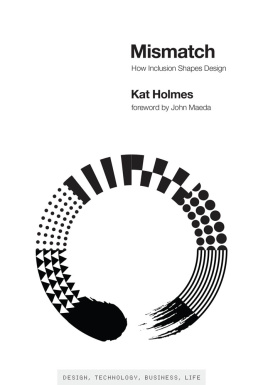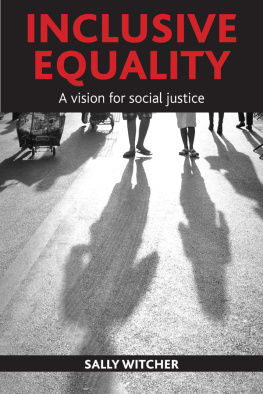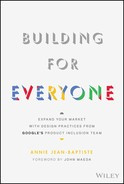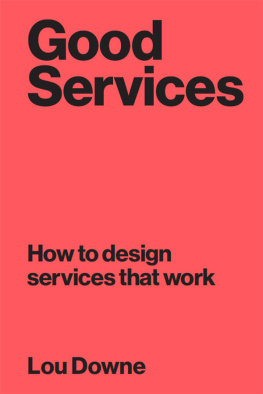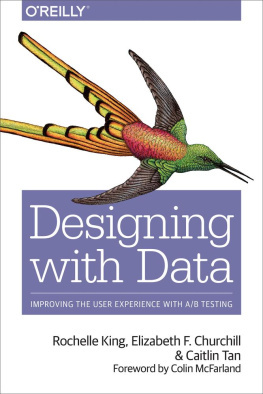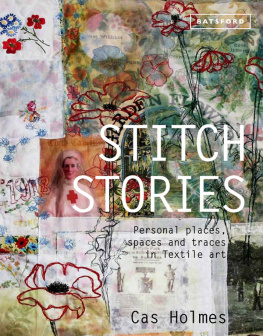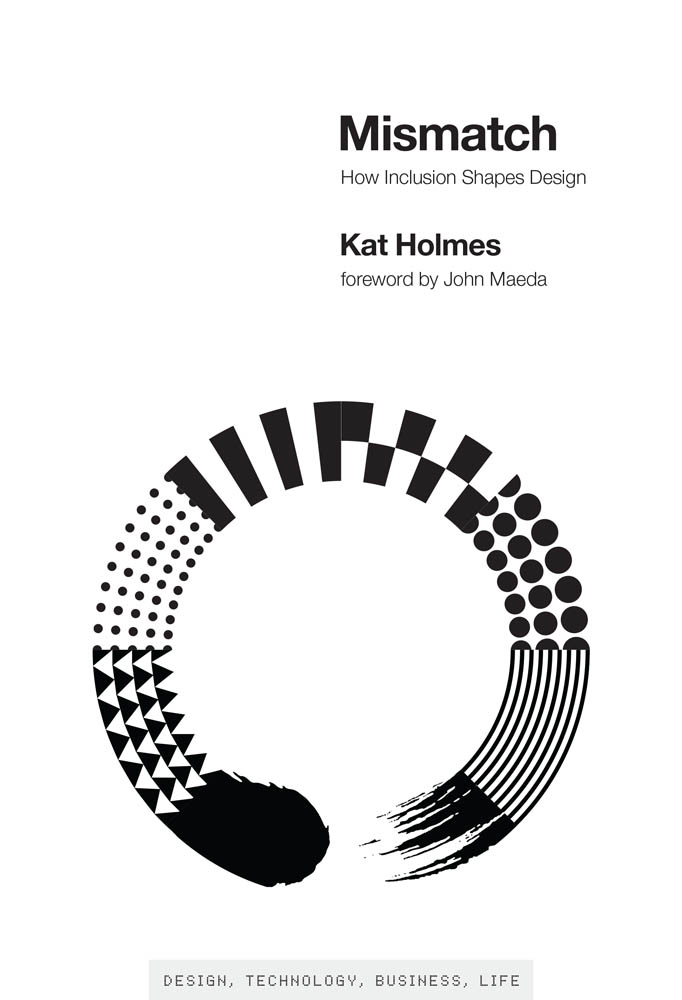
Simplicity: Design, Technology, Business, Life
John Maeda, Editor
The Laws of Simplicity, John Maeda, 2006
The Plenitude: Creativity, Innovation, and Making Stuff, Rich Gold, 2007
Simulation and Its Discontents, Sherry Turkle, 2009
Redesigning Leadership, John Maeda, 2011
Ill Have What Shes Having, Alex Bentley, Mark Earls, and Michael J. OBrien, 2011
The Storm of Creativity, Kyna Leski, 2015
The Acceleration of Cultural Change: From Ancestors to Algorithms, R. Alexander Bentley and Michael J. OBrien, 2017
Mismatch: How Inclusion Shapes Design, Kat Holmes, 2018
Mismatch
How Inclusion Shapes Design
Kat Holmes
The MIT Press
Cambridge, Massachusetts
London, England
2018 Kat Holmes
All rights reserved. No part of this book may be reproduced in any form by any electronic or mechanical means (including photocopying, recording, or information storage and retrieval) without permission in writing from the publisher.
Library of Congress Cataloging-in-Publication Data
Names: Holmes, Kat, author. | Maeda, John, writer of foreword.
Title: Mismatch : how inclusion shapes design / Kat Holmes ; foreword by John Maeda.
Description: Cambridge, MA : The MIT Press, 2018. | Series: Simplicity : design, technology, business, life | Includes .
Identifiers: LCCN 2018008099 | ISBN 9780262038881 (hardcover : alk. paper)
Subjects: LCSH: DesignAnthropological aspects. | Social integration. | Marginality, Social.
Classification: LCC NK1520 .H64 2018 | DDC 745.4dc23 LC record available at https://lccn.loc.gov/2018008099
ISBN: 978-0-262-03888-1
Retail e-ISBN: 978-0-262-34963-5
Library e-ISBN: 978-0-262-34962-8
MITP e-ISBN: 978-0-262-34961-1
For Scarlet, Sophia, and Don
Together, we are home.
Contents
When I started to blog about the topic of design in the early 2000s, it was a time when there were still DVD players and the iPhone hadnt emerged yet. The cloud was just starting to cover the horizon of the sky-of-user-experience, and technology was just starting to make us happier and yet unhappier too. There needed to be a way to connect how technologists make products with the way pre-technologies were crafted by designand thus the Laws of Simplicity (LoS) were born.
Luckily, I learned at an early enough age that I really dont have all the answers. So I have been actively looking these past few years for ways to think of design in the future by searching out the rising lights. A chance search hit on the Internet led me to the work of Kat Holmes on inclusive design. This was back when she was at Microsoftand frankly back then, Microsoft wasnt the first name youd think of when you wanted to imagine the future of design. But, I thought, This is it!
Because, spending time in Silicon Valley and working across hundreds of technology startups as a partner at venture capital firm Kleiner Perkins, I intuitively felt that Kat had the solution to something truly important. Inclusive design was what was missing in the tech products being shipped to millionsultimately leading to a fundamental mismatch between what people needed and what the techies in Silicon Valley were shipping out to them. I firmly believe that Kat holds the key to addressing the unfortunate set of common biases in how we make products in tech: for ourselves as a representative sample of the people in the world. So I reached out to her with a cold email and have been grateful ever since that she returned that first email message.
Kat Holmes brings us the right message about design, at just the right time. Her message isnt one of simplicity at allshe forces us to think about the complexity. According to how Kat sees the world, there can be no simplicity unless we understand the complexities of how and why products get built today. As you may recall, the 5th Law of Simplicity says:
Simplicity and complexity need each other.
Designing for simplicity tomorrow will be impossible unless we make the effort to understand the underlying complexities of how we design today. If we dont, well only create more mismatches. Well create experiences that are simple for people like ourselves, only.
We need to ask the difficult question of who gets to make the products that we use todaybecause it ties directly into what gets made. This is the central question that Kat helps us wade into, with tact, theory, and concrete actionable advice for how to navigate this new way to design that is essential for any product maker out there.
As Kat says, For better or worse, the people who design the touchpoints of society determine who can participate and whos left out. Often unwittingly. And, If design is the source of mismatches and exclusion, can it also be the remedy? Yes. But it takes work.
Good luck in doing that work. Im doing that work right now too.
John Maeda
Lexington, Massachusetts
March 2018
Soon after I agreed to write Mismatch, my house flooded. Fifty thousand gallons of water and thirty-five thousand words later, its all a bit of blur. These pages were written nomadically: in airplane seats, hotel lobbies, coffee shops, kitchen tables, library corners, and even on the front steps of several porches. Im deeply grateful to all the people who shared their homes, meals, and friendship with my family during this time. In particular, the Woodman, Wither-Wollersheim, and Grimes families, my mother, Sharon Tangney, and her husband Steve. You created the safe spaces that made this book possible.
John Maeda, thank you for encouraging me to write this book and making it seem like the obvious thing to do. Youve shown me what it means to open doors for others and I promise to pay it forward.
Bob Prior, your trust and creative partnership were a first-time authors dream. Thank you, and the MIT Press team, for the great care you brought to the nuanced topics in this book.
To the inclusive design leaders who contributed words to these pages: Tiffany Brown, John Porter, Victor Pineda, Sophia Holmes, Swetha Machanavajhala, Margaret Burnett, and Jutta Treviranusthank you for sharing your expertise and stories.
The Airlift crew, thank you for creating a cover illustration that perfectly captures the essence of this book.
Karen Chappelle, your thoughtful and playful illustrations bring an important dimension to the ideas in each chapter.
Chuck Mosher, you coached me through the hurdles of writing. You endured my messiest thoughts to carve out my key points. Thanks for loving me that much.
Molly McCue, thanks for your eloquent feedback and being my writing soulmate.
Rosemarie Garland-Thomson, our long chats on misfits and mismatches helped me fit disparate pieces into one puzzle. And thank you for showing me how to write with Dragon when my words were in my mouth, not my hands.
Seema Sairam, Patrick Corrigan, Hsiao-Ching Chou, Sarah Morris, and Kris Woolery, thanks for your honest edits and remarkable friendship.
Irada Sadykhova, your compassion and clarity are woven throughout this book. Thank you for constantly challenging me, and a generation of inclusive leaders, to expect more of ourselves and each other.
To the extended community of inclusive design leaders and enthusiasts, especially at Microsoft, thank you for your partnership and support.
And finally, to my partner, Don, the rock that our family is built upon. When I decided to write a book, you didnt even flinch. While I wrote, you shifted entire planets around me so I could focus. Remember when I made you read scores of disparate pages, over and over again, and then accused you of not
Next page
